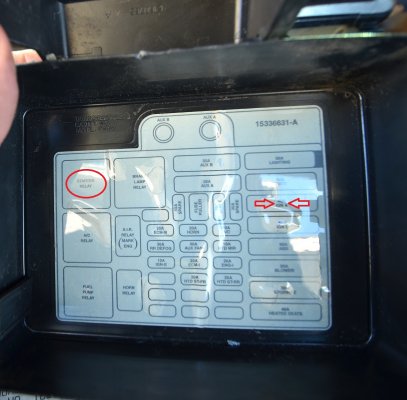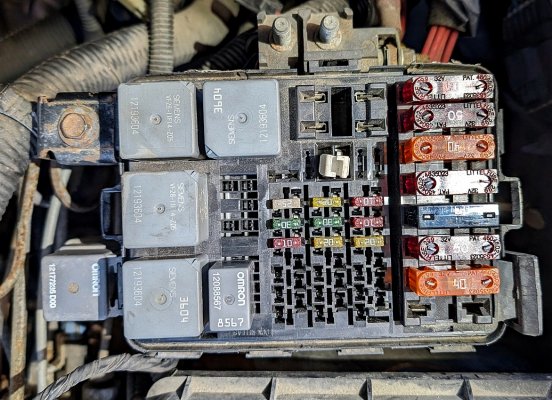You are using an out of date browser. It may not display this or other websites correctly.
You should upgrade or use an alternative browser.
You should upgrade or use an alternative browser.
98 K1500 motor swap but no start
- Thread starter DHud
- Start date
Disclaimer: Links on this page pointing to Amazon, eBay and other sites may include affiliate code. If you click them and make a purchase, we may earn a small commission.
By being a vortex you have positive to starter and another positive to undrhood fuse block. Positive to fuse block should be at battery then spacer then positive to starter and then bolt to battery holding both cables to battery
Thinking only way a starter would cause this is if when energized it created a dead short which would be pulling all voltage to ground or if engine was seized so that it couldn't rotate then starter would also be pulling maximum amps/volts . Can you rotate engine by hand or fairly easily ?
That's what I've got going on... here's a pic of what my positive looks like.By being a vortex you have positive to starter and another positive to undrhood fuse block. Positive to fuse block should be at battery then spacer then positive to starter and then bolt to battery holding both cables to battery
Yes, before this started happening, I was able to crank the motor with the key - but I had the Ignition Coil unplugged from the Distributor so I could build oil pressure prior to putting load on the motor at first start. Now I can't even do that anymore - even without ignition plugged in, I still get the "ping - dead" result.Thinking only way a starter would cause this is if when energized it created a dead short which would be pulling all voltage to ground or if engine was seized so that it couldn't rotate then starter would also be pulling maximum amps/volts . Can you rotate engine by hand or fairly easily ?
Attachments
Yes, before this started happening, I was able to crank the motor with the key - but I had the Ignition Coil unplugged from the Distributor so I could build oil pressure prior to putting load on the motor at first start. Now I can't even do that anymore - even without ignition plugged in, I still get the "ping - dead" result.
Re: Crank vs. 'No Crank' problem.
The symptoms you are describing are making me think that Schurkey's response in reply #9 is
where I would also go. However, in response you are showing solid connections in the suspect areas, so we
need to dig a little deeper in order to isolate the root cause of all this.
I am familiar with the starting/cranking circuit, and there are aren't any circuit breakers in it. When
troubleshooting a 'No Crank' issue, I like to break it in 1/2, the power side versus the control side.
My recommendation is that we first get the power side to work (manually) every single time we try it.
THEN we work to operate the now 'known-good' power side with the control side. So let's take a
look at how the Cranking circuit Power side is documented in the Factory Service Manual:
You must be registered for see images attach
The POWER side is simple. A RED wire originating at the 40A Fuse 6. (IGN A) And the input to this fuse is connected to the Always Hot power bus. (!)
When this red wire is connected to the PPL (purple) wire which goes down to the Starter Solenoid, the starter will begin cranking. (Assuming a good starter.)
How simple is that? Red to Purple and GO.
* SAFETY WARNING * Once you read past this point, you *must* employ 100% situational awareness at all times.
IF you elect to troubleshoot the cranking circuit, you must ensure that the engine is allowed to spin
without sending power to any wheels. If automatic, you must verify that the trans is either in Park or Neutral.
If a manual trans, then the shifter must be in the neutral position. I am writing this because the next troubleshooting
step will be bypassing the Neutral Safety Switch or Clutch Depressed Switch.
Chocking the wheels and/or having a helper on the brakes is also recommended.
Not to come across as an alarmist, for this troubleshooting procedure is routinely done by pros all the time.
And pros will take all the precautions necessary down at the muscle memory level. But for
folks new to the old truck hobby, these toys are big enough to really hurt you if you don't
account for all possible outcomes while troubleshooting. (Thanks for reading all this.)
****
Where were we? In English, removing the Starter Relay (in the Underhood Fuse Block)
and using a suitable 12-gauge jumper between Pin 30 and Pin 87 shown above, every
single time these 2 connections are jumpered together the engine must crank over.
If this doesn't happen every single time, stop, reverify, and fix as necessary the associated
parts of the electrical system until it does.
****
To recap, notice that there are -0- circuit breakers in the Power delivery side
of the starter relay cranking circuit. And if you are getting positive starter cranking
every time you jumper across these starter relay connections, then we can quit
worrying about the battery/connections/cables involved...and move on to the
Control side of this relay circuit. Which we'll discuss in the next reply.
You can refer to this as a Binary Search. Some prefer Divide & Conquer.
I've referred to this as the Building Block approach. Break the circuit apart
into smaller, logically-related chunks, and then prove each section individually,
and then work to build the next layer on top of the working one. And so on
and so forth. But when we are done there will be no guesswork, and only
changing of proven bad parts.
Fun stuff. :0)
Attachments
Last edited:
This is very helpful! I will start with these tips when I get home and see what we get... awesome way to think about it and break it down. That's the way my brain works as well.Re: Crank vs. 'No Crank' problem.
The symptoms you are describing are making me think that Schurkey's response in reply #9 is
where I would also go. However, in response you are showing solid connections in the suspect areas, so we
need to dig a little deeper in order to isolate the root cause of all this.
I am familiar with the starting/cranking circuit, and there are aren't any circuit breakers in it. When
troubleshooting a 'No Crank' issue, I like to break it in 1/2, the power side versus the control side.
My recommendation is that we first get the power side to work (manually) every single time we try it.
THEN we work to operate the now 'known-good' power side with the control side. So let's take a
look at how the Cranking circuit Power side is documented in the Factory Service Manual:
You must be registered for see images attach
The POWER side is simple. A RED wire originating at the 40A Fuse 6. (IGN A) And the input to this fuse is connected to the Always Hot power bus. (!)
When this red wire is connected to the PPL (purple) wire which goes down to the Starter Solenoid, the starter will begin cranking. (Assuming a good starter.)
How simple is that? Red to Purple and GO.
* SAFETY WARNING * Once you read past this point, you *must* employ 100% situational awareness at all times.
IF you elect to troubleshoot the cranking circuit, you must ensure that the engine is allowed to spin
without sending power to any wheels. If automatic, you must verify that the trans is either in Park or Neutral.
If a manual trans, then the shifter must be in the neutral position. I am writing this because the next troubleshooting
step will be bypassing the Neutral Safety Switch or Clutch Depressed Switch.
Chocking the wheels and/or having a helper on the brakes is also recommended.
Not to come across as an alarmist, for this procedure is routinely done by pros all the time.
And pros will take all the precautions necessary down at the muscle memory level. But for
folks new to the old truck hobby, these toys are big enough to really hurt you if you don't
account for all possible outcomes while troubleshooting. (Thanks for reading all this.)
Where were we? In English, removing the Starter Relay (in the Underhood Fuse Block)
and using a suitable 12-gauge jumper between Pin 30 and Pin 87 shown above, every
single time these 2 connections are jumpered together the engine must crank over.
If this doesn't happen every single time, stop, reverify, and fix as necessary the associated
parts of the electrical system until it does.
****
To recap, notice that there are -0- circuit breakers in the Power delivery side
of the starter relay cranking circuit. And if you are getting positive starter cranking
every time you jumper across these starter relay connections, then we can quit
worrying about the battery/connections/cables involved...and move on to the
Control side of this relay circuit. Which we'll discuss in the next reply.
You can refer to this as a Binary Search. Some prefer Divide & Conquer.
I've referred to this as the Building Block approach. Break the circuit apart
into smaller, logically-related chunks, and then prove each section individually,
and then work to build the next layer on top of the working one. And so on
and so forth. But when we are done there will be no guesswork, and only
changing of proven bad parts.
Fun stuff. :0)
Yes, the motor turns - when I married the flywheel to the torque converter, I was moving it by hand to get each bolt...So can you turn engine by hand ? If not disconnect battery negative and loosen starter so it won't be engaged in flywheel and then see if you can turn engine by hand
Similar threads
- Replies
- 5
- Views
- 211
- Replies
- 15
- Views
- 392




